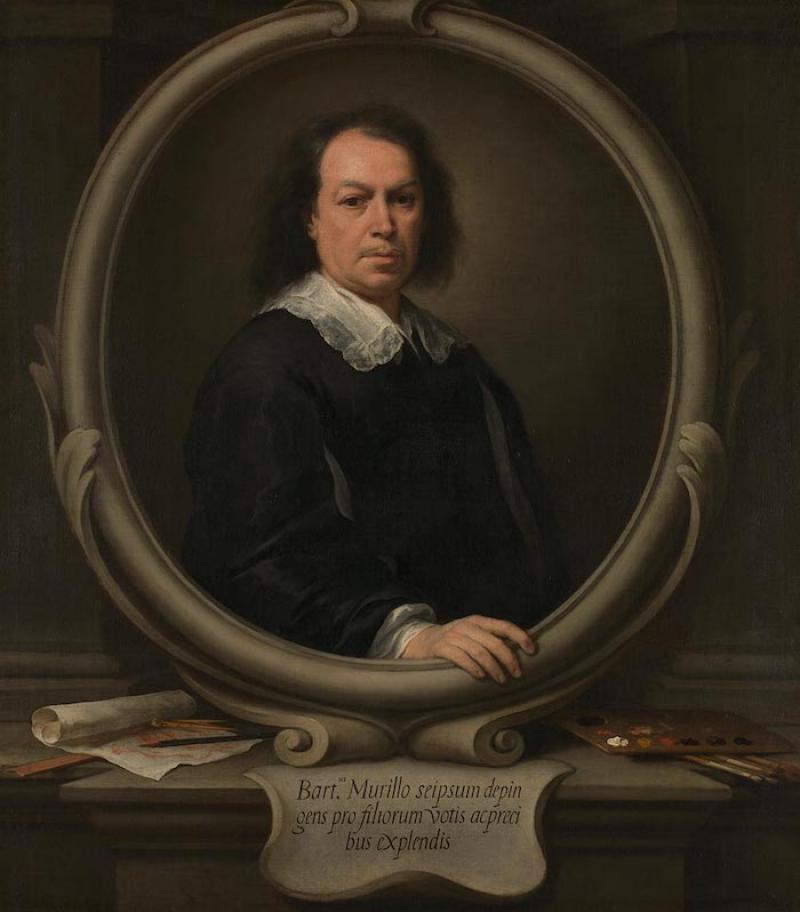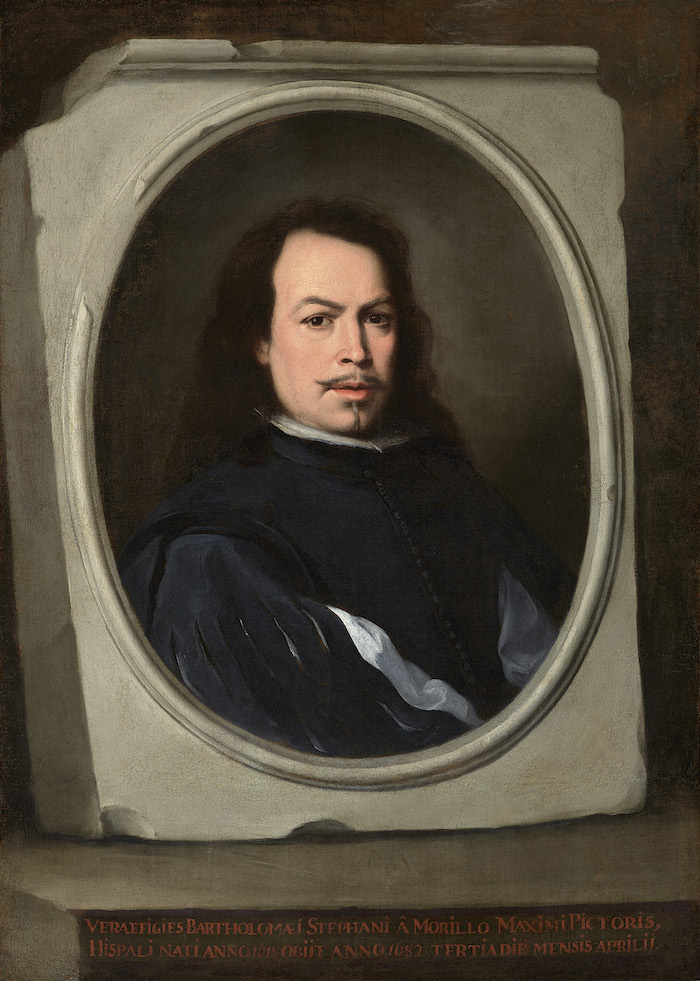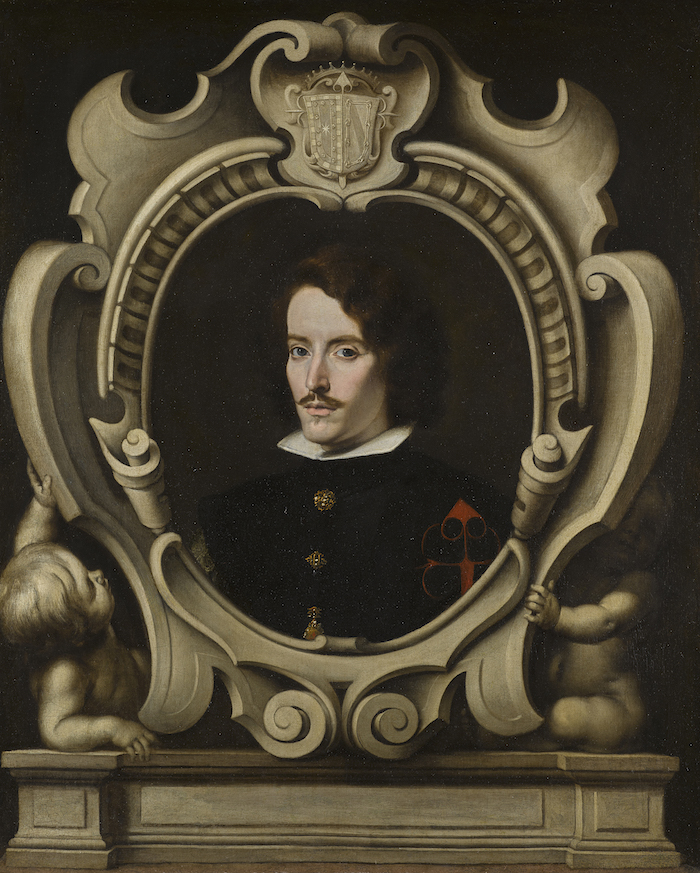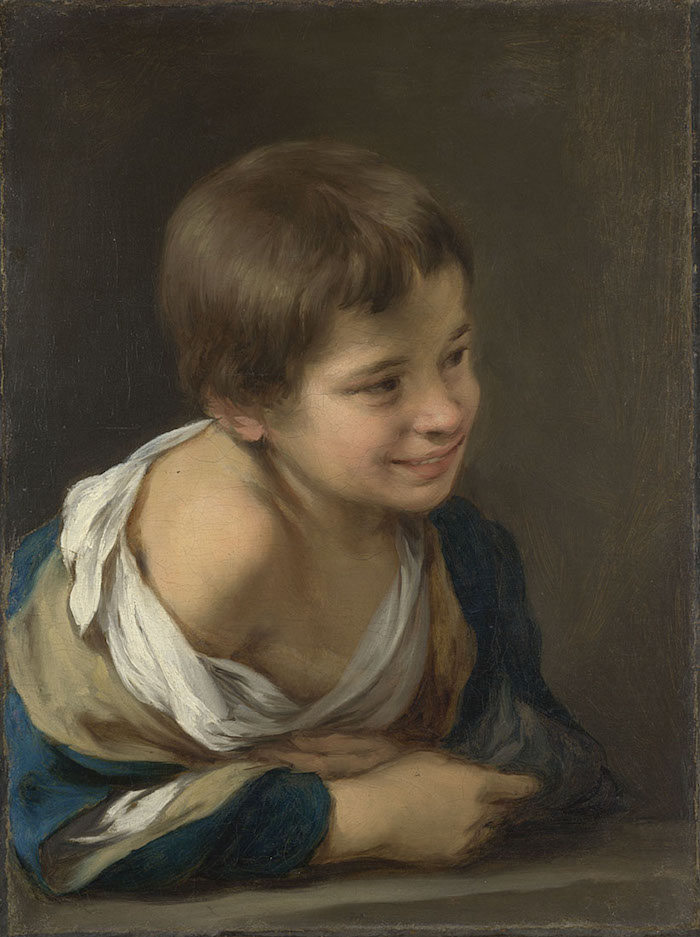Murillo: The Self-Portraits, National Gallery review - edged with darkness | reviews, news & interviews
Murillo: The Self-Portraits, National Gallery review - edged with darkness
Murillo: The Self-Portraits, National Gallery review - edged with darkness
Exquisite exhibition prompted by Murillo's two self-portraits considers what can survive time's wreckage

Mortality inflects commemoration. So it is with portraiture: the likeness – particularly those which celebrate lives of status and accomplishment – will always be limned with death.
The National Gallery’s tiny exhibition of Murillo’s two known self-portraits (Self-portrait, c. 1650-55 pictured below, and Self-portrait, c. 1670, main picture) – brought together for the first time since they were separated from the private collection of his son, Gaspar – is not only a tight and elegant reflection on Murillo’s art as he aged, but also a meditation on the purpose of portraiture and the way art carries messages across time. The single-room exhibition comprises eight paintings, an engraving, and three books displayed in a vitrine which posthumously commemorate Murillo’s work, and are held open at the pages displaying his portrait. Low lighting allows for the chiaroscuro of Murillo’s palette to punctuate the shadows and the division of his early work on one side of the room and later work on the opposite – each half clearly aligned with either the earlier or later self-portrait around which the exhibition has been constructed – draws sharp, if subtle, distinctions between his earlier, formally precise paintings, and his later, bolder work.
The single-room exhibition comprises eight paintings, an engraving, and three books displayed in a vitrine which posthumously commemorate Murillo’s work, and are held open at the pages displaying his portrait. Low lighting allows for the chiaroscuro of Murillo’s palette to punctuate the shadows and the division of his early work on one side of the room and later work on the opposite – each half clearly aligned with either the earlier or later self-portrait around which the exhibition has been constructed – draws sharp, if subtle, distinctions between his earlier, formally precise paintings, and his later, bolder work.
 To the left hang three portraits of young men painted in the early 1650s. Two bear Murillo’s distinctive interior stone frames, though to quite different effect. In Portrait of Juan Arias de Saavedra, 1650, little putti with distinctive button noses hold upright the family coat of arms, while in Portrait of Count Diego Ortiz de Zúñiga, 1655 (pictured right) one crawls out from behind the ogive to peer into the Count’s young, idealised face as if entranced by his preternaturally marmoreal features; another little putto seems anxious to escape the gloom behind the painted stone frame. In the third portrait, Young Man, 1650-1655, the paint is more freely handled and the boy appears more approachable, warm in his demeanour, though this may also be due to the vulnerability of impending adolescence, traces of which shadow his jaw and upper lip.
To the left hang three portraits of young men painted in the early 1650s. Two bear Murillo’s distinctive interior stone frames, though to quite different effect. In Portrait of Juan Arias de Saavedra, 1650, little putti with distinctive button noses hold upright the family coat of arms, while in Portrait of Count Diego Ortiz de Zúñiga, 1655 (pictured right) one crawls out from behind the ogive to peer into the Count’s young, idealised face as if entranced by his preternaturally marmoreal features; another little putto seems anxious to escape the gloom behind the painted stone frame. In the third portrait, Young Man, 1650-1655, the paint is more freely handled and the boy appears more approachable, warm in his demeanour, though this may also be due to the vulnerability of impending adolescence, traces of which shadow his jaw and upper lip.
To the right are paintings from the later years. The portraits in this selection are more frank and personal. That of Murillo’s great friend and patron, Portrait of Nicolás Omazur, 1672, is starkly allegorical. Omazur carries a skull, the fingers of his left hand gently caressing the cranium as if he could feel thought through the bone, while the right cups the occiput easily; but it’s the texture of his gaze that’s striking, as if he’s been caught mid-thought and is aware he is being observed but unwilling to meet his viewer’s eyes.
 Murillo’s ability to portray these most fleeting of expressions is displayed too in the small painting adjacent of a street urchin smiling out at something beyond the frame (A Peasant Boy Leaning on a Sill, c. 1675, pictured left). It’s a smile that reaches to his eyes and pulls up his shoulders to his neck in pure joy – a fizz of happiness enlivening a moment like the sun coming out and quite possibly as quickly dissipated. In its impermanence it shares something with the early portraits, namely an understanding of the speed with which the phenomena that constitute life disperse. But whereas the early portraits seem to vye with mortality and aim for remembrance across the ages, the later works embrace this impermanence and respect, if not revel, in it.
Murillo’s ability to portray these most fleeting of expressions is displayed too in the small painting adjacent of a street urchin smiling out at something beyond the frame (A Peasant Boy Leaning on a Sill, c. 1675, pictured left). It’s a smile that reaches to his eyes and pulls up his shoulders to his neck in pure joy – a fizz of happiness enlivening a moment like the sun coming out and quite possibly as quickly dissipated. In its impermanence it shares something with the early portraits, namely an understanding of the speed with which the phenomena that constitute life disperse. But whereas the early portraits seem to vye with mortality and aim for remembrance across the ages, the later works embrace this impermanence and respect, if not revel, in it.
It’s this shift in Murillo’s understanding of what constitutes life and death that is the pivot of the exhibition. Between the two self-portraits is a hinge. To the left is a young, confident, rakish young man who meets his viewers’ eyes with bombast and challenge. To the right is the older man, revered as a great artist but knocked, perhaps, by circumstance. His circumspect glance doesn’t quite meet ours but slides to the side, as if aware of company but more taken by his own thoughts.
If as a young man Murillo appeared assured of his ability to project his own image into the future, in later life he portrays himself as wiser, able to see beyond his painted frames to the darker edges.
- Murillo: The Self Portraits at the National Gallery until 21 May, free
- Read more visual arts reviews on theartsdesk
rating
Share this article
The future of Arts Journalism
You can stop theartsdesk.com closing!
We urgently need financing to survive. Our fundraising drive has thus far raised £49,000 but we need to reach £100,000 or we will be forced to close. Please contribute here: https://gofund.me/c3f6033d
And if you can forward this information to anyone who might assist, we’d be grateful.

Subscribe to theartsdesk.com
Thank you for continuing to read our work on theartsdesk.com. For unlimited access to every article in its entirety, including our archive of more than 15,000 pieces, we're asking for £5 per month or £40 per year. We feel it's a very good deal, and hope you do too.
To take a subscription now simply click here.
And if you're looking for that extra gift for a friend or family member, why not treat them to a theartsdesk.com gift subscription?
more Visual arts
 'We are bowled over!' Thank you for your messages of love and support
Much-appreciated words of commendation from readers and the cultural community
'We are bowled over!' Thank you for your messages of love and support
Much-appreciated words of commendation from readers and the cultural community
![SEX MONEY RACE RELIGION [2016] by Gilbert and George. Installation shot of Gilbert & George 21ST CENTURY PICTURES Hayward Gallery](https://theartsdesk.com/sites/default/files/styles/thumbnail/public/mastimages/Gilbert%20%26%20George_%2021ST%20CENTURY%20PICTURES.%20SEX%20MONEY%20RACE%20RELIGION%20%5B2016%5D.%20Photo_%20Mark%20Blower.%20Courtesy%20of%20the%20Gilbert%20%26%20George%20and%20the%20Hayward%20Gallery._0.jpg?itok=7tVsLyR-) Gilbert & George, 21st Century Pictures, Hayward Gallery review - brash, bright and not so beautiful
The couple's coloured photomontages shout louder than ever, causing sensory overload
Gilbert & George, 21st Century Pictures, Hayward Gallery review - brash, bright and not so beautiful
The couple's coloured photomontages shout louder than ever, causing sensory overload
 Lee Miller, Tate Britain review - an extraordinary career that remains an enigma
Fashion photographer, artist or war reporter; will the real Lee Miller please step forward?
Lee Miller, Tate Britain review - an extraordinary career that remains an enigma
Fashion photographer, artist or war reporter; will the real Lee Miller please step forward?
 Kerry James Marshall: The Histories, Royal Academy review - a triumphant celebration of blackness
Room after room of glorious paintings
Kerry James Marshall: The Histories, Royal Academy review - a triumphant celebration of blackness
Room after room of glorious paintings
 Folkestone Triennial 2025 - landscape, seascape, art lovers' escape
Locally rooted festival brings home many but not all global concerns
Folkestone Triennial 2025 - landscape, seascape, art lovers' escape
Locally rooted festival brings home many but not all global concerns
 Sir Brian Clarke (1953-2025) - a personal tribute
Remembering an artist with a gift for the transcendent
Sir Brian Clarke (1953-2025) - a personal tribute
Remembering an artist with a gift for the transcendent
 Emily Kam Kngwarray, Tate Modern review - glimpses of another world
Pictures that are an affirmation of belonging
Emily Kam Kngwarray, Tate Modern review - glimpses of another world
Pictures that are an affirmation of belonging
 Kiefer / Van Gogh, Royal Academy review - a pairing of opposites
Small scale intensity meets large scale melodrama
Kiefer / Van Gogh, Royal Academy review - a pairing of opposites
Small scale intensity meets large scale melodrama
 Jenny Saville: The Anatomy of Painting, National Portrait Gallery review - a protégé losing her way
A brilliant painter in search of a worthwhile subject
Jenny Saville: The Anatomy of Painting, National Portrait Gallery review - a protégé losing her way
A brilliant painter in search of a worthwhile subject
 Abstract Erotic, Courtauld Gallery review - sculpture that is sensuous, funny and subversive
Testing the boundaries of good taste, and winning
Abstract Erotic, Courtauld Gallery review - sculpture that is sensuous, funny and subversive
Testing the boundaries of good taste, and winning
 Edward Burra, Tate Britain review - watercolour made mainstream
Social satire with a nasty bite
Edward Burra, Tate Britain review - watercolour made mainstream
Social satire with a nasty bite
 Ithell Colquhoun, Tate Britain review - revelations of a weird and wonderful world
Emanations from the unconscious
Ithell Colquhoun, Tate Britain review - revelations of a weird and wonderful world
Emanations from the unconscious

Add comment